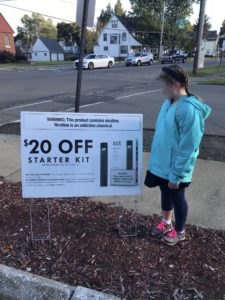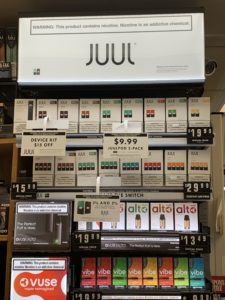Welcome to CounterTobacco.org’s “News and Research Roundup!” Each month we post a summary of the latest research, reports, and news stories on counteracting tobacco product sales and marketing at the point of sale (POS). Keeping up with what’s happening in the POS movement all across the country can help you choose policies and strategies that work best for your community. New research can help provide support for your work and evidence for the importance of the “War in the Store.” Have a story you don’t want us to miss? E-mail it to us!
New Research
Tobacco Retailer Density
- Association between density and proximity of tobacco retail outlets with smoking: A systematic review of youth studies, Health & Place
- This systematic review includes 35 peer-reviewed articles that document the associations between youth smoking behaviors and tobacco retailer density or proximity to homes, schools, and community spaces. The review found a positive
 association between tobacco retailer density and youth smoking behaviors, especially for retailer density near youths’ homes and, to a lesser degree, near schools. The review, however, did not provide evidence of a positive relationship between proximity of tobacco retailers to homes or schools and youth smoking behavior, indicating that the number of tobacco retailers nearby may be a more important factor than proximity alone. The researchers suggest that policies that reduce the overall tobacco retailer density in a neighborhood may help reduce youth smoking. Learn more about tobacco retailer density.
association between tobacco retailer density and youth smoking behaviors, especially for retailer density near youths’ homes and, to a lesser degree, near schools. The review, however, did not provide evidence of a positive relationship between proximity of tobacco retailers to homes or schools and youth smoking behavior, indicating that the number of tobacco retailers nearby may be a more important factor than proximity alone. The researchers suggest that policies that reduce the overall tobacco retailer density in a neighborhood may help reduce youth smoking. Learn more about tobacco retailer density.
- This systematic review includes 35 peer-reviewed articles that document the associations between youth smoking behaviors and tobacco retailer density or proximity to homes, schools, and community spaces. The review found a positive
Flavored Tobacco Products
- Trends and associations of menthol cigarette smoking among US middle and high school students – National Youth Tobacco Survey, 2011-2018, Nicotine & Tobacco Research
- Analyzing data from the 2011-2018 National Youth Tobacco Survey, researchers found
 that, overall, menthol cigarette smoking decreased significantly over this time period among current youth cigarette smokers (from 57.3% to 45.7%), while non-menthol cigarette use significantly increased (from 38.2% to 47.3%). However, while menthol cigarette smoking decreased among non-Hispanic white and high school smokers, it remained unchanged among Hispanic, non-Hispanic black, and middle school smokers. Young adults who smoked menthol cigarettes also smoked more days per month, more cigarettes per day, and more cigarettes over their lifetime compared to those who smoked non-menthol cigarettes. Learn more about menthol tobacco products.
that, overall, menthol cigarette smoking decreased significantly over this time period among current youth cigarette smokers (from 57.3% to 45.7%), while non-menthol cigarette use significantly increased (from 38.2% to 47.3%). However, while menthol cigarette smoking decreased among non-Hispanic white and high school smokers, it remained unchanged among Hispanic, non-Hispanic black, and middle school smokers. Young adults who smoked menthol cigarettes also smoked more days per month, more cigarettes per day, and more cigarettes over their lifetime compared to those who smoked non-menthol cigarettes. Learn more about menthol tobacco products.
- Analyzing data from the 2011-2018 National Youth Tobacco Survey, researchers found
E-Cigarettes
- Dependence on e-cigarettes and cigarettes in a cross-sectional study of US adults, Addiction
- Using cross-sectional data from the 2013-2016 Population Assessment of Tobacco and Health (PATH) study, researchers assessed nicotine dependence in current and former e-cigarette, cigarette, and dual users. For both former and current users, dependence on e-cigarettes was significantly lower than dependence on cigarettes; this finding was consistent for dual and single product users and among daily and non-daily users. Learn more about e-cigarettes at the point of sale.
- Youth perceptions of Juul in the United States, JAMA Pediatrics
- In January and February of 2019, researchers surveyed over 1,100 youth and young
 adults, ages 14 to 24, to determine perceptions about Juul. Nearly all of the sample (88%) had heard of Juul, and 79% believed “juuling” was dangerous. 72% of the sample believed Juul to be a gateway to other substance use, with the most commonly cited substance of use being cigarettes. Additionally, researchers examined reasons for youth use of Juul; over half of the sample (62%) reported youth used Juul products for social reasons, citing Juul as being “trendy and cool”, while only 5% of youth mentioned flavor as a reason for youth use. Learn more about industry youth appeal tactics.
adults, ages 14 to 24, to determine perceptions about Juul. Nearly all of the sample (88%) had heard of Juul, and 79% believed “juuling” was dangerous. 72% of the sample believed Juul to be a gateway to other substance use, with the most commonly cited substance of use being cigarettes. Additionally, researchers examined reasons for youth use of Juul; over half of the sample (62%) reported youth used Juul products for social reasons, citing Juul as being “trendy and cool”, while only 5% of youth mentioned flavor as a reason for youth use. Learn more about industry youth appeal tactics. - News story: Juuling among US youth is about the cool factor, new study suggests, The Conversation
- In January and February of 2019, researchers surveyed over 1,100 youth and young
- School proximity and census tract correlates of e-cigarette specialty retail outlets (vape shops) in Central Texas, Preventative Medicine Reports
- This study out of Austin, Texas examined the sociodemographic makeup of communities where vape shops were located and the proximity of these shops to local schools. The researchers found that vape shops were more likely to be located in neighborhoods classified as “poverty areas,” but were less likely to be located in neighborhoods with more non-Hispanic Blacks and residents ages 10-14. Almost half (40%) of vape shops were located within half a mile of a middle or high school. The presence of sociodemographic disparities in vape shop location and the close proximity of vape shops to schools suggest a need for more comprehensive tobacco control policies. Learn more about disparities in retailer density.
Point of Sale Advertising and Marketing
- Changes in tobacco product advertising at point of sale: 2015-2018, Pediatrics
- Between 2015 and 2018, researchers assessed tobacco industry advertising at 141
 tobacco retailers, all within a half mile of high schools in New Jersey, to determine how the point-of-sale environment near youth changed over time. Overall, the changes in advertising mirrored the national youth use rates of the various products. Exterior and interior e-cigarette advertisements decreased from 2015 to 2017 but increased in presence, volume, and percentage of advertisements in 2018. Cigarette advertisements declined in presence and share of advertisements on the exterior of storefronts, but remained stable over the years in the interior of stores. On the contrary, cigar advertisements increased in presence and volume for both the interior and exterior of stores. This study concludes that the point-of-sale environment around schools may have an influence on youth use of tobacco products. Learn more about restricting tobacco advertising.
tobacco retailers, all within a half mile of high schools in New Jersey, to determine how the point-of-sale environment near youth changed over time. Overall, the changes in advertising mirrored the national youth use rates of the various products. Exterior and interior e-cigarette advertisements decreased from 2015 to 2017 but increased in presence, volume, and percentage of advertisements in 2018. Cigarette advertisements declined in presence and share of advertisements on the exterior of storefronts, but remained stable over the years in the interior of stores. On the contrary, cigar advertisements increased in presence and volume for both the interior and exterior of stores. This study concludes that the point-of-sale environment around schools may have an influence on youth use of tobacco products. Learn more about restricting tobacco advertising.
- Between 2015 and 2018, researchers assessed tobacco industry advertising at 141
International
- Impact of tobacco tax increases and industry pricing on smoking behaviors and inequalities: A mixed-methods study, Public Health Research
- This report evaluated consumer behaviors in relation to increasing tobacco taxes and industry pricing tactics from 2002 to 2016 in the UK. The researchers found that when higher taxes on tobacco were implemented, some smokers attempted to quit smoking; however, many simply switched to more affordable brands, cut down but did not quit, or used less tobacco when rolling their own cigarettes. While smokers with a lower income had difficulties purchasing tobacco when its price increased, these individuals were not more likely to quit and instead turned to cheaper products to smoke. The researchers also found that when tobacco prices increased, purchase of duty-free tobacco and smuggling of tobacco products did not increase. Learn more about increasing tobacco prices.
- Perceptions of harmfulness of heated tobacco products compared to combustible cigarettes among adult smokers in Japan: Findings from the 2018 ITC Japan survey, International Journal of Environmental Research and Public Health
- This study assessed differences in perceptions of harm of heated tobacco products
 (HTPs), which are promoted by the industry in Japan as reduced-risk tobacco products, between exclusive cigarette smokers and smokers who concurrently use both cigarettes and HTPs. 44% of exclusive smokers, compared to 62% of dual smokers, perceived HTPs to be less harmful than cigarettes; as well, frequent users of HTPs were significantly more likely to perceive HTPs as less harmful than cigarettes, compared to infrequent HTP users. Out of the entire sample, believing HTPs to be less harmful than cigarettes was associated with exposure to HTP advertising on all media channels (e.g. TV, social media) and at the point of sale. Learn more about non-cigarette tobacco products at the point of sale.
(HTPs), which are promoted by the industry in Japan as reduced-risk tobacco products, between exclusive cigarette smokers and smokers who concurrently use both cigarettes and HTPs. 44% of exclusive smokers, compared to 62% of dual smokers, perceived HTPs to be less harmful than cigarettes; as well, frequent users of HTPs were significantly more likely to perceive HTPs as less harmful than cigarettes, compared to infrequent HTP users. Out of the entire sample, believing HTPs to be less harmful than cigarettes was associated with exposure to HTP advertising on all media channels (e.g. TV, social media) and at the point of sale. Learn more about non-cigarette tobacco products at the point of sale.
- This study assessed differences in perceptions of harm of heated tobacco products
- Global review of tobacco product flavour policies, Tobacco Control
- This article reviews tobacco product flavor policies in 39 countries, 11 of which are part of the European Union. The researchers determined that the most common tobacco product covered in flavor policies was cigarettes and that menthol was included in the flavor bans of 8 countries plus the 11 countries in the EU. Across policies, the definition of flavor varied, with some definitions based on additives or ingredients and other definitions based on taste or aroma. The authors suggest that countries wanting or planning to implement a flavor ban should build off the comprehensive flavor policies currently in place around the world. Learn more about flavored tobacco products and policy options such as restricting tobacco product availability.
- Tobacco industry tactics to circumvent and undermine the menthol cigarette ban in the UK, Tobacco Control
- In 2016, the UK passed legislation banning the sale of cigarettes with characterizing flavor, including menthol, and provided the industry with a transitional period until May 2020 to prepare for the ban. This article suggests that, during this transitional period, the tobacco industry increased their menthol sales, rather than weaning sales and preparing for the ban. As well, the tobacco industry launched new products, like
 menthol accessories sold separately but to be used in conjunction with cigarette packs, to circumvent the menthol ban. The writers of this article provide suggestions for closing loopholes to prevent similar industry tactics from occurring elsewhere. Learn more about menthol tobacco products and restrictions on tobacco product availability.
menthol accessories sold separately but to be used in conjunction with cigarette packs, to circumvent the menthol ban. The writers of this article provide suggestions for closing loopholes to prevent similar industry tactics from occurring elsewhere. Learn more about menthol tobacco products and restrictions on tobacco product availability. - News story: Tobacco companies minting it before Wednesday’s UK menthol cigarette ban, EurekAlert!
- In 2016, the UK passed legislation banning the sale of cigarettes with characterizing flavor, including menthol, and provided the industry with a transitional period until May 2020 to prepare for the ban. This article suggests that, during this transitional period, the tobacco industry increased their menthol sales, rather than weaning sales and preparing for the ban. As well, the tobacco industry launched new products, like
- ‘It has candy. You need to press on it’: Young adults’ perceptions of flavoured cigarettes in the Philippines, Tobacco Control
- In 2019, researchers in the Philippines conducted 8 focus groups with 63 young adults, ages 18-24, to determine perceptions on flavored cigarette packaging. Participants believed that some menthol-flavored cigarettes were less harmful than other flavored or non-flavored cigarettes, and that menthol cigarettes in blue packaging were less harmful than menthol cigarettes in green packaging. Many participants also found flavor capsule packs to be most attractive, due to the coloring of the packages and the expectations of a candy-like taste. The researchers suggest that plain packaging and a flavor ban may help to minimize misperceptions that menthol-flavored products are less harmful and to reduce the appeal of tobacco products to youth. Learn more about menthol and flavored tobacco products at the point of sale.
Health Warnings
- Tool to assess appeal-aversion response to graphic warning labels on cigarette packs among US smokers, Tobacco Control
- In this study, researchers had a sample of adult daily smokers from San Diego, California perform a discrete choice appeal-aversion purchasing task to determine how much the participants would be willing to pay to avoid purchasing cigarette packs with certain graphic health warnings. The researchers found that 46% of participants would be willing to pay a 50% or more premium than their regular pack of cigarettes to have a branded pack, rather than a pack with a graphic health warning. These findings suggest that graphic health warnings may instill price aversion and reduce cigarette purchasing. Learn more about health warnings.
Other
- Asking for identification and retail tobacco sales to minors, Pediatrics
- Researchers assessed retailer compliance in 2017 and 2018 using data from federal
 compliance reports from 17 states. They found that, during 80% of compliance checks, retailers did, indeed, ask minors for identification. However, nearly a quarter of violations occurred after identification was requested. As well, violations were 42% more likely to occur when youth asked for a vaping product, as opposed to cigarettes. Learn more about youth and tobacco products.
compliance reports from 17 states. They found that, during 80% of compliance checks, retailers did, indeed, ask minors for identification. However, nearly a quarter of violations occurred after identification was requested. As well, violations were 42% more likely to occur when youth asked for a vaping product, as opposed to cigarettes. Learn more about youth and tobacco products.
- Researchers assessed retailer compliance in 2017 and 2018 using data from federal
- ‘Being politically active does not have to be difficult.’ A content analysis of tobacco industry-sponsored advocacy websites, Tobacco Control
- In this article, researchers examined six advocacy websites sponsored by the tobacco industry. They determined the most common themes across these websites were tobacco taxes, advocacy resources, and pleas for action. According to the authors of this article, pro-tobacco advocacy websites are a tobacco industry strategy used to build relationships with consumers and reach policy objectives; monitoring these sites may help tobacco control advocates gain awareness of and counter industry pro-tobacco policies. Learn more about industry tactics.
COVID-19
- Smoking is associated with COVID-19 progression: A meta-analysis, Nicotine & Tobacco Research
- In this meta-analysis of 19 peer-reviewed papers, researchers found that smokers had 1.91 times the odds of COVID-19 progression compared to non-smokers, highlighting that smoking is a risk factor for COVID-19.
- Change in tobacco and electronic cigarette use and motivation to quit in response to COVID-19, Nicotine & Tobacco Research
- In this cross-sectional study, researchers assessed quit attempts in 366 dual cigarette and e-cigarette users, as well as motivation to quit, due to COVID-19. More than a third had increased motivation to quit cigarettes and e-cigarettes; as well, almost a quarter reported a quit attempt of either product. Approximately a quarter also decreased use of cigarettes and e-cigarettes as a result of COVID-19.
Industry News
- Juul donated to New Jersey politicians even as they considered vaping restrictions, Politico

- Embattled Juul to scale back global reach, relocate headquarters, Bloomberg
- Philip Morris sues FDA over plans for graphic warning labels, Bloomberg
- Patent lawsuit tied to IQOS, CSP Daily News
- Federal regulators agree to investigate BAT complaint, Winston-Salem Journal
- Rona Ambrose, Canada’s former health minister, joins e-cigarette company Juul’s board of directors, CBC
POS Policy in the Media
E-Cigarettes
- FDA warns manufacturers and retailers to remove certain e-cigarette products targeted to youth from the market, FDA.gov
- [CA] With new vaping ban, Palo Alto expects smoke shops to shutter, Palo Alto Online
- Strong legislation helps defeat e-cigarettes in Finland, World Health Organization Regional Office for Europe
Tobacco 21
- Town of Buena Vista, Colorado ordinance no. 5, The Chaffee County Times
- [MN] Eagan City Council increases age to purchase tobacco to 21, Sun Thisweek
- [MN] Walz signs bill that raises age to buy tobacco, vape products to 21, KSTP.com
- Legislation raising age to buy tobacco to 21 officially becomes law in Oklahoma, OKCFox.com
Menthol and Other Flavored Tobacco Products
- [Jackson, WY] Town to pursue ban on sale of flavored e-cigarettes, Buckrail.com

- [CA] Pleasanton bans flavored tobacco and e-cig products, The Independent
- [CA] Oakland bans sale of flavored, menthol tobacco products in tobacco stores, pharmacies, CBSN Bay Area
- California Senate Committee passes flavored tobacco ban, HalfWheel.com
- Michigan appeals court sides with vape shop, against flavored vaping ban, Bridge Magazine
Health Warnings
- FDA seeks delay of graphic cigarette warnings due to virus, Law 360
- Lawsuits filed to overturn FDA graphic cigarette warnings, CSP
Other
- School districts are suing Walgreens over youth vaping, Education Week
Find more stories in last month’s News and Research Roundup.
Know of a story that we missed? Email us, and we’ll be sure to include it in next month’s roundup!


